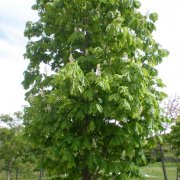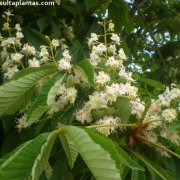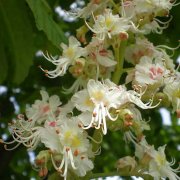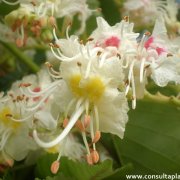Care of the tree Aesculus hippocastanum or Horse chestnut |
|
The genus Aesculus, family Sapindaceae, includes 15 species of trees and shrubs native to the temperate Northern Hemisphere. Some species and hybrids are: Aesculus hippocastanum, Aesculus indica, Aesculus x carnea, Aesculus californica. Common names: Horse chestnut, European horsechestnut, Spanish chestnut, Buckeye, Conker tree. This species is native to the Balkan Peninsula, Europe. They are deciduous trees with a rounded crown that reach 20 meters (65.61 feet) in height and 18 meters (59 feet) in width. They have palmate leaves up to 20 cm (7.87") in length made up of 5-7 dark green leaflets. The attractive white flowers with a yellow or red center appear in erect conical panicles. They bloom in late spring. The fruits are spiny capsules. Horse chestnut is used as isolated specimens and shade trees in large gardens and in public parks. They resist pollution from cities. Aesculus hippocastanum grows in full sun and semi-shade exposures. It resists frost well. European horsechestnut prefers well-drained soils that contain abundant organic matter. Planting is done in early spring or autumn. Water regularly, waiting until the substrate has almost completely dried; they resist a few days of drought. Fertilize in autumn with compost or manure. Prune lightly in late winter to keep it compact. Spanish chestnut can be attacked by fungi if there is excess moisture. Conker tree is propagated from seeds sown in spring and by grafting. |
Images of the tree Aesculus hippocastanum or Horse chestnut |
Find plants
Aesculus hippocastanum or Horse chestnut | Care and Growing
© 2026 FavThemes





